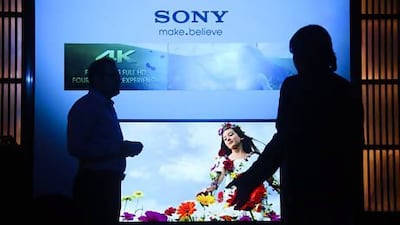Sony, which is emerging from five years of brutal restructuring that gutted its workforce and product line-up, wants to show off a few new things.
There is the Aromastic, a digital smell dispenser, AeroSense self-flying drones and a collection of tech-infused accessories called “wena”.
These gadgets are being dreamed up by the Seed Accelerator Program, started by the chief executive Kazuo Hirai in 2014 to encourage invention and risk-taking.
With Sony back on solid financial footing, shown by its estimate-topping results in the latest quarter, the company has more breathing room to experiment. Instead of focusing on raw, technical innovation, the devices coming out of the lab hark back to an era when Sony was able to take existing technology and combine it with slick marketing to create must-have gadgets such as the Walkman and Handycam. Another hit product could help Mr Hirai cement his legacy as the one who not only turned Sony around, but got it inventing again.
“Sony has returned to being a company where our employees have the confidence and energy to pursue new businesses for the future,” Mr Hirai said at Sony’s annual investor day in May. SAP products “foster a culture of constantly doing new things within Sony and help to develop an entrepreneurial mindset and skill set among junior employees.”
So far, more than 1,600 Sony employees in Japan - just 1.2 percent of the global total - have been allowed to put their day jobs on hold to pitch new ideas. The most promising ones, including AeroSense, have led to the creation of 12 new products. The programme was expanded to Europe late last year, and more regions are under consideration.
All of this has come amid tight control over development costs. Sony spent ¥447.5 billion (Dh14.6 million) on research in the latest fiscal year, an 18 per cent decline from a decade ago. In the same period, Sony’s workforce has also shrunk to about 125,000 from 180,000. The company currently spends about 6 per cent of revenue on R&D, compared with about 7 per cent for Samsung Electronics.
At the accelerator programme, staff are expected to pitch new ideas for products or services every quarter. After a vetting process, the top proposals are presented to senior executives. Those who pass the final hurdle leave their departments, getting office space and budget. They also get access to Sony’s manufacturing and marketing operations to bring products to market.
“Mr Hirai encouraging internal innovation fosters a certain ambition among employees who then feel enfranchised, but this looks like it will remain a sideshow at present,” said Jean-Louis Lafayeedney, an analyst at Haitong International Securities Group, the only one out of 29 tracked by Bloomberg who has a sell rating on the stock.
Mr Lafayeedney said Sony has looming issues that need to be addressed, such as a large, domestic insurance business that will suffer from Japan’s worsening demographics and negative interest rates. He also said management at the film division is too reliant on sequels and remakes. “Is it going to build the Walkman? Who knows?" he said of the accelerator programme. “For the time being it seems quite irrelevant.”
Unsurprisingly, the Sony Accelerator Program has been inundated by Sony veterans eager to show off ideas kept in the closet for years. But it’s drawing a younger generation of workers. One, Teppei Tsushima, already knew he wanted to work on smartwatches when he was at Osaka University. Within months of joining Sony in 2014, he corralled co-workers into formalising a successful pitch.
Apart from watches, Mr Tsushima and his team developed chip-embedded leather and metal wrist straps that can attach to any watch, giving them smart capabilities such as digital payments and tracking. Mr Tsushima, 27, now runs wena, which stands for “wear electronics naturally” and wants to expand beyond the wrist to things that, for example, could blur the lines between earphones and necklaces.
One of the dozen winners over the past three years is Shuji Fujita, who invented the Aromastic. After joining Sony in 2009 with a doctorate, he spent years in the research department working on batteries. A chance conversation with a colleague on the train a couple years ago led to a weekend of brainstorming at the local library. There, he dusted off an old idea: a small device that dispenses different smells to stimulate thinking. The next week, he pitched it and went on to win the quarterly vetting process.
“I really think this was only possible at Sony," said Mr Fujita, 37, who now runs day-to-day operations for Aromastic, currently available only in Japan. At the push of a button, the lipstick-sized device dispenses one of five scents in close proximity to the user, so as not to disturb others. It costs ¥8,980 and fragrance cartridges, which last about two to four weeks, are sold for up to ¥2,780.
Sony will not release sales figures for the device, but Mr Fujita says he is working to expand shipments, including overseas. Mr Hirai referred to Aromastic as the “Walkman of fragrances” in April. On a recent visit to its Tokyo headquarters, it was dangling from the neck straps of a few employees.
The accelerator has also gone beyond electronic gadgets. In late 2014, Sony Real Estate, an online property brokerage emerged from the programme. It is part of Sony’s often-overlooked financial arm, which last year generated more profit than its PlayStation division. Productivity app maker A10 Lab was also spun out of the incubator.
Other gadgets include a digital lock, recording tools for concert halls, robot toys, electronic paper watches and a device that combines several remote controls into one. None of these products are close to making a meaningful contribution to Sony’s bottom line, but analysts are applauding Sony’s efforts to spur invention again.
“It’s things like this that led to creation of the Trinitron TV or the Walkman,” said Kiyoto Utsumi, an analyst at Tachibana Securities.
* Bloomberg

